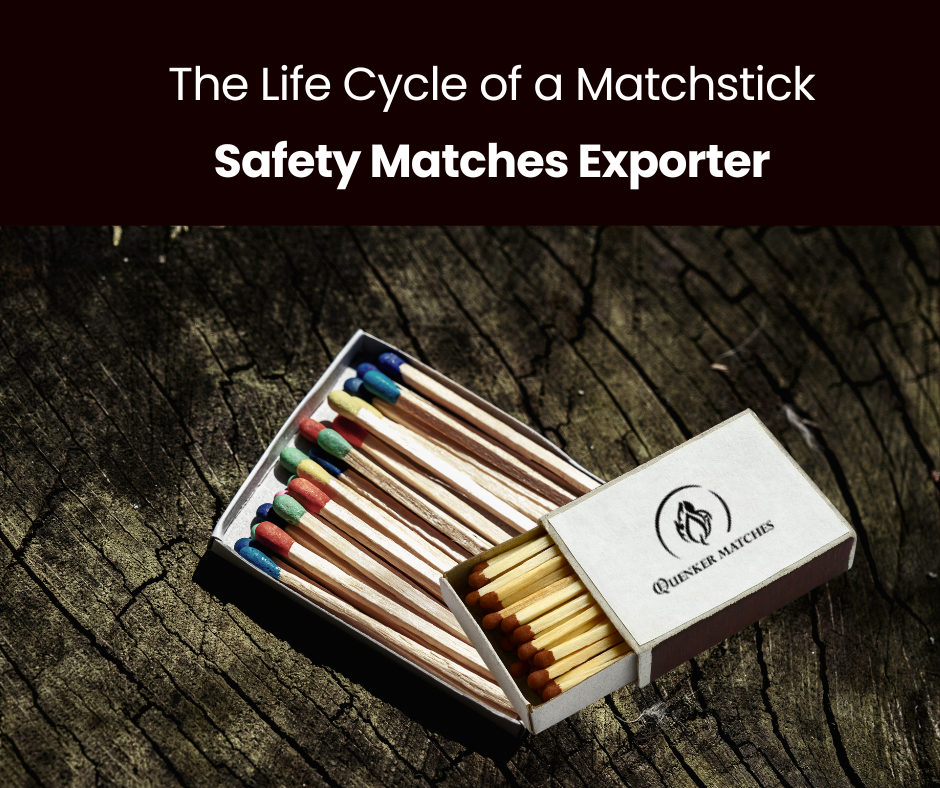
Why Indian Safety Matches Are Trusted Across Nigeria, South Africa, and Beyond?
Rise of Indian Safety Matches Manufacturers
India is the biggest exporter of safety matches in the world, and countries like Nigeria and South Africa trust Indian matches more than any others. Why? Because Indian manufacturers have a long history of making matches that are safe, work well, and don’t cost too much.
This blog will explain why people in Africa rely on Indian-made matches. We’ll look at how they perform, how they’re packed to stay dry and safe, how affordable they are, and how Indian companies are making matches in ways that are better for the environment. All these reasons make Indian safety matches the top choice wherever people need a reliable spark.
Quality Matchstick Manufacturing: Precision from Start to Finish
India’s match manufacturing industry is built on a foundation of strict quality control and advanced production techniques. Each step in the manufacturing process, from harvesting the raw wood to final packaging, is designed to ensure that every matchstick lights instantly and burns evenly.
Why this matters:
Consistent ignition: Indian safety matches are known for lighting on the first strike, a critical feature regardless of humidity or weather conditions.
Durability: The wooden splints used are sourced and treated to resist breaking during handling and transport.
Variety: Odorless and smokeless variants cater to households and industries that prioritize clean and comfortable burning.
Moisture-resistant packaging: Especially important for tropical climates like Nigeria, Ghana, and Tanzania, Indian manufacturers use specialized packaging to keep matches dry and functional even in high humidity.
Economical Pricing with Uncompromised Quality
One of the major advantages Indian exporters offer is the ability to produce safety matches in massive volumes at competitive prices, without compromising on quality. This balance of cost and quality has been a decisive factor for many importers across Africa and the Middle East.
Key benefits for importers:
Bulk availability: Large-scale manufacturing capabilities mean India can meet demands for thousands or millions of matchsticks with ease.
Stable pricing: Predictable costs help retailers and distributors plan inventory and pricing strategies efficiently.
Flexible packaging: From basic bulk cartons to customized branded boxes and private labels, Indian exporters accommodate diverse buyer preferences.
How Indian Matches Compare Globally
The quality and pricing advantage is evident when we compare Indian safety matches with products from other exporting countries.
Feature
India
Other Exporters
Strike Rate
95–98%
80–85%
Packaging Customization
High
Moderate
Cost per 1000 sticks
Low
Medium to High
Minimum Order Quantity (MOQ)
Flexible
Often Restrictive
Compliance with Safety Norms
Strong
Variable
Key Markets for Indian Safety Matches
Nigeria: An Expanding Safety Matches Market with Unique Challenges
With a population exceeding 200 million, Nigeria represents one of the largest consumer bases for safety matches in Africa. Urbanization continues to grow rapidly, but a significant portion of the population still relies on matches for cooking, lighting, and other daily needs.
South Africa: Africa’s Leading Importer of Quality Matches
South Africa stands out as a premium market where consumers prioritize quality and safety. Indian matches’ consistent ignition and clean burning qualities align well with South African buyers’ expectations, making India a preferred supplier.
Ghana, Benin, Togo, Tanzania: Growing Demand Across West and East Africa
These countries are experiencing steady growth in demand for safety matches, driven by rising populations and expanding urban centers. Indian exporters benefit from their strong distribution networks and product adaptability, serving both rural and metropolitan customers effectively.
UAE: A Crucial Re-export Hub for Safety Matches
The United Arab Emirates plays a strategic role as both a consumer and a re-exporter of safety matches. Indian matches imported into the UAE often find their way to other Middle Eastern and African markets, amplifying India’s global reach.
Nepal and Yemen: Emerging Markets in South Asia and the Middle East
India’s proximity and trade agreements make it a natural supplier for countries like Nepal and Yemen, where safety matches remain essential household items.
Consistent Quality You Can Test and Trust
Quality consistency is vital for importers, as substandard matches can lead to:
Damage to brand reputation
Increased consumer dissatisfaction and complaints
Risk of regulatory penalties due to non-compliance
Indian manufacturers mitigate these risks through multiple layers of quality assurance:
Multi-stage quality control: Each phase, from drying the wooden splints to applying chemical coatings, undergoes rigorous checks.
Ignition testing: Matches are tested to guarantee a uniform strike rate.
Moisture control: Specialized packaging protects the product from damp conditions, which is critical for tropical markets.
Eco-Friendly Practices Aligning with Modern Buyer Values
Today’s consumers and retailers are increasingly eco-conscious, making sustainability an important consideration for match exporters.
Indian manufacturers are responding by adopting:
Renewable wood sourcing: Using timber from managed and sustainable forests.
Non-toxic chemicals: Avoiding harmful substances to ensure user safety.
Biodegradable packaging: Reducing environmental impact.
Green manufacturing: Utilizing solar power and energy-efficient machinery.
These measures not only help exporters meet global environmental standards but also enhance brand appeal in eco-aware markets.
Ready to Start Importing Indian Safety Matches?
If you’re planning to import safety matches, here are some practical tips:
Choose exporters experienced in your target market: They understand local regulations and distribution challenges.
Look for SGS or ISO certifications: These verify manufacturing and quality standards.
Consider private-label options: Custom branding can differentiate your product.
Ensure clear communication and flexible logistics: To keep supply chains smooth and responsive.
Final Thoughts
From flame consistency and climate-proof packaging to pricing that makes sense and certifications that speak volumes, Indian safety matches manufacturers have proven themselves across borders.
In the kitchens of Lagos, the stores of Soweto, and the markets of Nairobi, Indian matches are more than utility—they’re a trusted tool. And as sustainability, quality, and reliability take center stage in global trade, India’s flame shows no sign of flickering out.
Ready to strike a partnership that lights up your market? Quenker Matches are poised to deliver—just like their matches, every time.









